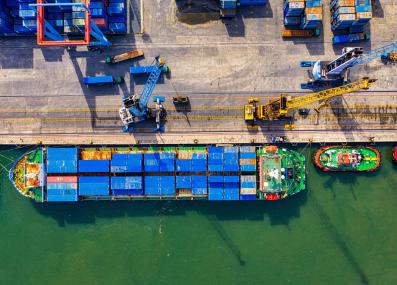New to climate change?
Sea Transport
Ships are the bloodstream of the world economy, responsible for more of the global flow of goods than all other forms of transport combined.1 In 2023, seagoing vessels, from oil tankers to container ships, carried more than 12 billion tons of goods: roughly 1.5 tons for every person on Earth.2 And all that shipping produces climate pollution—mainly carbon dioxide (CO2), the most important greenhouse gas fueling climate change. What comes out of ships’ smokestacks also drags down air quality and poses risks to people’s health.3
Ships—especially those moving goods, but also cruise liners, fishing vessels and others—are responsible for around 3% of humanity’s CO2 emissions.4 Given how much freight they move, that’s impressively low; ships produce less CO2 than trucks or planes in moving cargo a given distance.
But these ships do create climate pollution, and tackling it is a big engineering challenge. It’s also politically and economically complicated. By nature, the industry is international, so countries have to cooperate to make meaningful change. And commercial ships can stay in use for decades, so the global fleet changes slowly. That slow turnover also means we don’t have time to waste: The way we build ships today will have climate consequences for decades to come.
New fuels
Virtually all of the energy used in international shipping comes from burning fossil fuels. Most of that is heavy fuel oil, left over from oil refining.4
Engineers have proposed several new shipping fuels, including methanol, ammonia, biofuels, and hydrogen. These fuels could greatly lower the climate pollution from shipping, but none is ready to do so at scale today.
Even the cleanest fuels—like hydrogen, which can power a ship through a “fuel cell” that produces only harmless water vapor—have to be manufactured. Today, hydrogen, methanol, and ammonia are all primarily made from fossil fuels, and that production itself emits greenhouse gases.5 Each of these fuels can be made from non-fossil resources, in ways that create significantly less climate pollution, but these methods are not yet economically competitive. Alternative fuels demand a careful accounting of all their “well-to-wake” emissions, or the total greenhouse gases they produce both before and after they reach a ship’s engine room.
Using these fuels is also trickier than just swapping them in for oil. Certain biofuels can be burned in conventional ship engines without much trouble, but most alternative fuels require new ship designs or extensive modifications to existing ships. Recently, companies have started investing in ships that can run on both conventional and alternative fuels, or that could switch to a lower-carbon fuel without big changes.6 New fuels also come with their own safety considerations. For example, ammonia is toxic, so leaks are dangerous. Transitioning to new fuels will mean putting in place new equipment and strict protocols to ensure safety.5
The shipping industry will also have to consider how new fuels will be transported, stored at ports, and loaded into ships. Certain alternative fuels might be able to leverage parts of the vast system that’s been built for fuel oil. Some are already widely used, meaning networks exist to transport and distribute them. (Ammonia, for instance, is a key ingredient in fertilizer.) Even so, a wholesale switch to alternative fuels in the shipping industry will require a lot of new infrastructure.7
Shipping is not alone in these challenges. Aviation, heavy land transport, and some heavy industries are also seeking cleaner fuels. That provides a big economic opportunity, but also a hard road to scaling up supply chains to meet so much competing demand.
Thinking beyond fuel
Nuclear power can also be used at sea. Some military vessels and icebreaker ships are already powered by nuclear reactors, which produce no CO2 at all.5 New, smaller reactors like ready-to-use “nuclear batteries,”8 and new regulations to ensure their safety at sea, might help make this a viable solution for commercial shipping as well.
Electric batteries are also being considered for ships, both in hybrid setups and as a ship’s sole power source. Today, all-electric is mainly seen as an option for boats that make shorter, near-shore journeys.9 Batteries are bulky and present their own safety concerns, and long sea voyages have enormous energy demands with little opportunity to recharge. Ships with batteries also need new charging infrastructure at the ports where they dock. But as battery technologies and costs continue to improve, new opportunities could appear for some sectors of shipping.
Changing the industry
Ships that ply the seas today can also cut their climate pollution by reducing how much fuel they use.
Modern ships that use digital systems can optimize their speed and other parameters based on weather conditions and port congestion. Operators can choose the most efficient routes and save fuel. Even regularly cleaning a ship’s hull or using special paints can help: reducing drag makes the vessel more streamlined.9 These measures won’t eliminate the shipping industry’s climate pollution, but they can lower it in the near term—which is important, given the long process of renewing the global fleet. They also smooth the way to transition to cleaner fuels in the future, by putting less strain on the supply chains for new fuels as they develop.
The challenges to low-carbon shipping are large. But the international nature of shipping does offer opportunities to roll out large-scale changes. The International Maritime Organization (IMO), the United Nations agency that regulates global shipping, aims to zero out greenhouse gas emissions from the industry by about 2050.10 Already, ships above a certain size engaged in international voyages must calculate and report their CO2 emissions and efficiency, and make plans to improve if they don’t meet certain thresholds.11 The IMO also recently approved draft regulations that would set increasingly strict limits on the well-to-wake emissions of ships’ fuels.12 Ships using more polluting fuels would have to pay, while the best-performing ships would get rewards, creating an incentive for the industry to pursue steadily cleaner shipping.
April 28, 2025.
1 International Transport Forum. (2023). ITF Transport Outlook 2023. https://doi.org/10.1787/b6cc9ad5-en. The share attributed to each mode of transport is calculated based on tonne-kilometers of freight carried.
2 United Nations Conference on Trade and Development. (2024). Review of Maritime Transport 2024.
3 Zhang, Yiqi, et al. "Global air quality and health impacts of domestic and international shipping." Environmental Research Letters 16 (2021). https://doi.org/10.1088/1748-9326/ac146b.
4 International Maritime Organization. (2020). Fourth IMO Greenhouse Gas Study 2020.
5 United States Department of Energy. (2024). An Action Plan for Maritime Energy and Emissions Innovation.
6 Tomos, Branwen Ap Dafydd, et al. "Decarbonising international shipping—A life cycle perspective on alternative fuel options." Energy Conversion and Management 299 (2024). https://doi.org/10.1016/j.enconman.2023.117848.
7 International Renewable Energy Agency. (2021). A Pathway to Decarbonise the Shipping Sector by 2050.
8 Buongiorno, Jacopo, et al. "A strategy to unlock the potential of nuclear energy for a new and resilient global energy-industrial paradigm." The Bridge 51 (2021).
9 United States Department of Transportation, Maritime Administration. (2022). Energy Efficiency and Decarbonization Technical Guide.
10 International Maritime Organization. "2023 IMO strategy on reduction of GHG emissions from ships." Accessed April 2025.
11 International Maritime Organization. "Short-term GHG reduction measure." Accessed April 2025.
12 International Maritime Organization. "IMO approves net-zero regulations for global shipping." (11 April 2025). Accessed April 2025.









